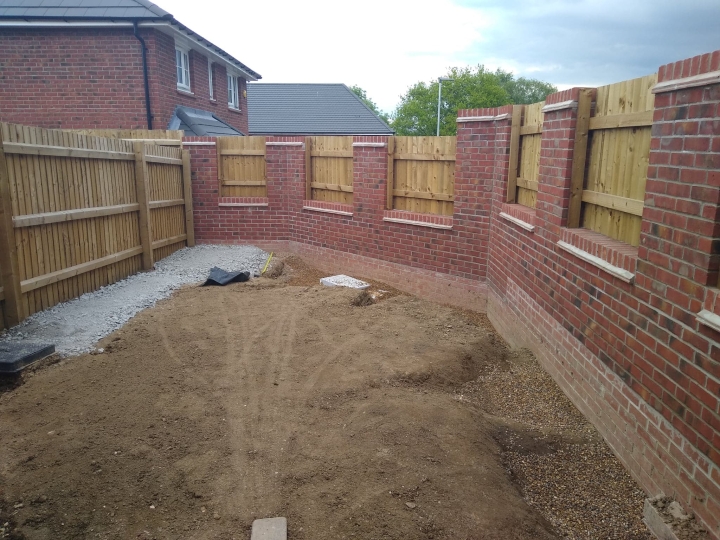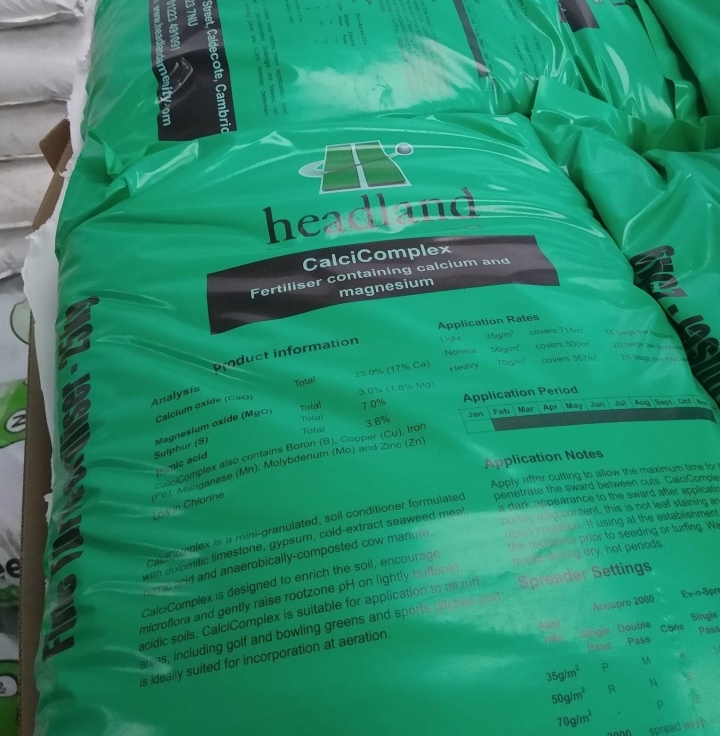How to Fix a Waterlogged Lawn - Why Me!
We're forever complaining about the weather regardless (even in the tropical West Midlands), but in recent years it is becoming the case increasingly that a month or two worth of rainfall can mount up in just a week - or even over a weekend. If this is a sign of the times then how can we deal with this for our lawns?
Why does my grass get waterlogged so easily?
Firstly, different areas possess differing soils. A light, sandy soil will allow for improved drainage in times of heavy rainfall. Unfortunately for us, we've only Lichfield and surrounding villages where this is applicable with soils much more clay-based in the vast majority of our West Midlands coverage area. This isn't all bad news providing the given lawn is cared for as clay soils have advantages too.
When it comes to drainage however, clay soils drain very slowly indeed. This is due to the particle size of clays being extremely small - not visible to the naked eye and with it, the air spaces between clay particles being extremely small, thereby reducing drainage capabilities.
Sand particles on the other hand are large in comparison - large to the point that we can feel them between our fingers. Sand based surfaces are preferred on many sports pitches for this reason. However it does mean that they require more water and more fertiliser - two things that not all homeowners are too keen to invest in anyway!
How does waterlogging harm a lawn?
A waterlogged soil (or a soil at it's 'field capacity') has all of its air pockets filled with water, rather than 50% air as we would ideally want for a healthy lawn. These anaerobic soil conditions cause harm to root systems - with roots dying back dependent on the severity of the waterlogging.
Soil can become compacted by the weight of standing water, or by walking a waterlogged lawn. Taking machinery onto a waterlogged lawn is a huge mistake. We want to perform operations such as lawn aeration and lawn renovations to relieve compaction on lawns, not create it!
As lawns dry out, grass will be thinner given the thinner root structures that were able to survive. It's important that lawns receive their next lawn treatment service visit shortly following a waterlogged spell as nutrients will have been washed out of the soil, and the damp, thinner lawn may well be prone to moss.

The rivers Tame and Anker in flood in the background along with one of our lawns near Tamworth
What can be done about a waterlogged lawn?
In the short term, much like when a lawn is frozen, the first course of action would be to keep off the lawn. Walking on, or taking machinery onto a waterlogged lawn can only increase levels of compaction within the soil structure. Lawns rarely exceed their 'field capacity' for long, and any standing water will soon start to move into the soil when space has been found for it. Where standing water persists, further action will likely be required.
What about spiking a waterlogged lawn?
Considering the above, do not be tempted by taking a garden fork to a waterlogged lawn. This will compound the problem rather than solve it. You will be making holes for the water to pool in and move nowhere. When the ground is saturated, then it is saturated and in this case we can't beat nature.
As touched on above, when lawns can take the weight of foot traffic again then usual annual lawn treatments will aid recovery. This patient approach is your only option for now, but there are a range of medium and long term options from this point... below I'm going to share my 'heavyweight action' and 'lawn care action'.
'Heavyweight' action for a waterlogged lawn
If waterlogging is extreme and regular, how your lawn is draining will need to be investigated by a drainage specialist such as a landscape gardener. This is the most expensive option, but could be the best move if repairs and moss invasion is frequent for longer term reduced cost and frustration.
A common solution being the installation of a soakaway. This, similar to a milk crate creates empty space beneath the lowest, wettest area of your lawn, allowing gravity to pull excess water downwards. Surrounding a soakaway with pea gravel and / or sports sand is advisable to help this process of excess water filtering through the soil and into increasing larger air spaces.
We would recommend consulting a specialist if this work is required otherwise you risk paying cheap and paying twice. We have viewed many lawns which have sunken dramatically following substandard drainage work and have resulted in a still wet, now very uneven lawn. We recommend consulting a landscaper before such a project who have the machinery, knowledge and experience.

Drainage in the form of a soakaway and pea gravel being added to this new build garden prior to some hard landscaping and re-instating a lawn
Infrequent waterlogging - lawn care action
If grass cover has been significantly damaged, with moss and soil compaction becoming troublesome then a lawn renovation may be required. This is typically made up of scarification, aeration and overseeding.
This can be achieved in the spring for a quick turnaround following winter waterlogging, but the usual watering requirements will be required for seed to germinate. Spring can often be cool and dry, so patience will be required early in the year.
We would only recommend this course of action where the drainage properties within the soil are good, and this was more of a freak flood. We wouldn't want to carry out a lawn renovation for us to be back to square one should the following year be a wet winter also.
Our recommendation - lawn aeration and soil improver applications
When drainage work is either out of budget or perceived as overkill for the standard of lawn you desire, we commonly recommend:
- Our five-step lawn maintenance programme
- Annual lawn aeration in good spring or autumn conditions with an application of our granular soil improver
- A second application of soil improver in spring / autumn
This is a common programme that we use on new build lawns, those with poor drainage or clay based soils. This is a common lawn care programme for lawns we look after in and around Coventry for lawn care services as an example. Clay soils compact more easily than sands, so mechanical aeration while being followed up with the best possible products for the soil are a must for a successful lawn care programme.
I've written a few blog articles along with us having this comprehensive webpage on lawn aeration and how an annual inclusion is a great way to enhance your lawn. The lesser discussed product being our soil improver...


Left: An example product that we have used as our soil improver product, with increasing options available and (right) three of our lawn aerators ready for action as part of our lawn care services
Soil Improver Applications
With clay soils common in our coverage area, this is a frequently used product!
This product contains gypsum for soil deflocculation. This means that the clay particles are less able to stick together as commonly experienced with clay soils. Our aim is to make the soil more friable.
This doesn't happen overnight, hence our typical recommendation of two of these applications per year, which we apply at a generous rate too.
There is a range of other benefits within this product thanks to an organic base to stimulate the soil biology, and humic acid to aid root development - perfect following aeration.
Our soil improver is also high in both calcium and magnesium (two major nutrients for your lawn) which aids grass health and colour.
The product can be applied all year around, but we like to make applications on a regular basis in late spring and autumn, just prior to the most stressful periods for your lawn of winter and summer.
Can we help?
You can see that we have a great deal of experience when it comes to fixing a waterlogged lawn, along with clay soils and how they need to be managed a little differently. Our five step lawn treatment service with aeration and soil improver applications is a common one that many homeowners with soft, soggy winter lawns will gain great returns from with a wide range of products as well as mechanical aeration.
If we can help with your lawn this year, then please feel free to get in touch via the contact form below, by getting an Instant Estimate, or you can call us on 01827 826123.
